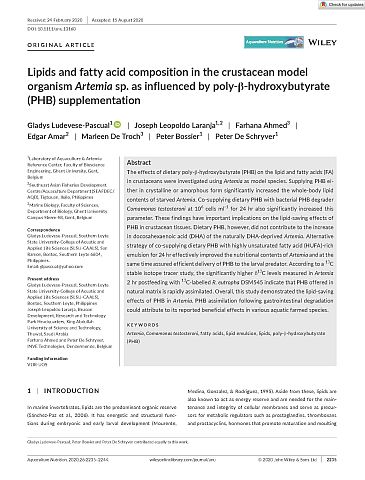Lipids and fatty acid composition in the crustacean model organism Artemia sp. as influenced by poly‐β‐hydroxybutyrate (PHB) supplementation
- Global styles
- MLA
- Vancouver
- Elsevier - Harvard
- APA
- Help

View/
Date
2020-12Author
Page views
3,000ASFA keyword
AGROVOC keyword
Taxonomic term
Metadata
Show full item record
Share
Abstract
The effects of dietary poly-β-hydroxybutyrate (PHB) on the lipid and fatty acids (FA) in crustaceans were investigated using Artemia as model species. Supplying PHB either in crystalline or amorphous form significantly increased the whole-body lipid contents of starved Artemia. Co-supplying dietary PHB with bacterial PHB degrader Comamonas testosteroni at 106 cells ml−1 for 24 hr also significantly increased this parameter. These findings have important implications on the lipid-saving effects of PHB in crustacean tissues. Dietary PHB, however, did not contribute to the increase in docosahexaenoic acid (DHA) of the naturally DHA-deprived Artemia. Alternative strategy of co-supplying dietary PHB with highly unsaturated fatty acid (HUFA)-rich emulsion for 24 hr effectively improved the nutritional contents of Artemia and at the same time assured efficient delivery of PHB to the larval predator. According to a 13C stable isotope tracer study, the significantly higher δ13C levels measured in Artemia 2 hr postfeeding with 13C-labelled R. eutropha DSM545 indicate that PHB offered in natural matrix is rapidly assimilated. Overall, this study demonstrated the lipid-saving effects of PHB in Artemia. PHB assimilation following gastrointestinal degradation could attribute to its reported beneficial effects in various aquatic farmed species.
Suggested Citation
Ludevese-Pascual, G., Laranja, J. L., Ahmed, F., Amar, E., De Troch, M., Bossier, P., & De Schryver, P. (2020). Lipids and fatty acid composition in the crustacean model organism Artemia sp. as influenced by poly‐β‐hydroxybutyrate (PHB) supplementation. Aquaculture Nutrition , 26(6), 2235-2244. https://doi.org/10.1111/anu.13160
Type
ArticleISSN
1353-5773; 1365-2095Collections
- Journal Articles [1258]
Related items
Showing items related by title, author, creator and subject.
-
Evaluation of dietary freeze-dried Chaetoceros calcitrans supplementation to control Vibrio harveyi infection on Penaeus monodon juvenile
Seraspe, Ebonia B.; Gabotero, Shirleny; de la Peña, Milagros R.; Pahila, Ida G.; Amar, Edgar (Elsevier, 2014)
Effects of supplementation of diets with freeze-dried Chaetoceros calcitrans to control Vibrio harveyi infection are evaluated through immune responses, and disease resistance of juvenile Penaeus monodon. Total lipid and ...
(Elsevier, 2014)
Effects of supplementation of diets with freeze-dried Chaetoceros calcitrans to control Vibrio harveyi infection are evaluated through immune responses, and disease resistance of juvenile Penaeus monodon. Total lipid and ... -
The essential fatty acid requirement of milkfish (Chanos chanos Forsskal)
Borlongan, Ilda G. (Springer Verlag, 1992)The essential fatty acid (EFA) requirement of milkfish was examined by a 12-week feeding trial using defined, purified diets at water temperature of 28–29°C and salinity of 32‰. The test diets contained varying levels of ... -
Fatty acid composition of five candidate aquaculture species in Central Philippines
Ogata, Hiroshi Y.; Emata, Arnil C.; Garibay, Esteban S.; Furuita, Hirofumi (Elsevier, 2004)Fatty acid composition was determined in five candidate aquaculture species, mangrove red snapper (Lutjanus argentimaculatus), two rabbitfish (Siganus guttatus and S. canaliculatus), coral trout (Plectropomus leopardus) ...





